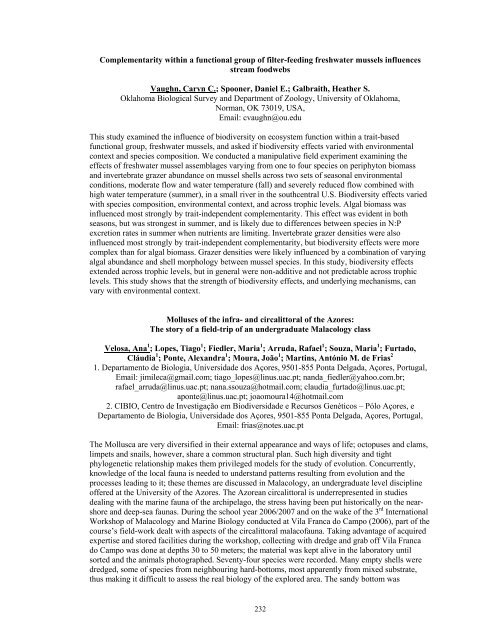World Congress of Malacology Antwerp ... - Unitas Malacologica
World Congress of Malacology Antwerp ... - Unitas Malacologica
World Congress of Malacology Antwerp ... - Unitas Malacologica
You also want an ePaper? Increase the reach of your titles
YUMPU automatically turns print PDFs into web optimized ePapers that Google loves.
Complementarity within a functional group <strong>of</strong> filter-feeding freshwater mussels influences<br />
stream foodwebs<br />
Vaughn, Caryn C.; Spooner, Daniel E.; Galbraith, Heather S.<br />
Oklahoma Biological Survey and Department <strong>of</strong> Zoology, University <strong>of</strong> Oklahoma,<br />
Norman, OK 73019, USA,<br />
Email: cvaughn@ou.edu<br />
This study examined the influence <strong>of</strong> biodiversity on ecosystem function within a trait-based<br />
functional group, freshwater mussels, and asked if biodiversity effects varied with environmental<br />
context and species composition. We conducted a manipulative field experiment examining the<br />
effects <strong>of</strong> freshwater mussel assemblages varying from one to four species on periphyton biomass<br />
and invertebrate grazer abundance on mussel shells across two sets <strong>of</strong> seasonal environmental<br />
conditions, moderate flow and water temperature (fall) and severely reduced flow combined with<br />
high water temperature (summer), in a small river in the southcentral U.S. Biodiversity effects varied<br />
with species composition, environmental context, and across trophic levels. Algal biomass was<br />
influenced most strongly by trait-independent complementarity. This effect was evident in both<br />
seasons, but was strongest in summer, and is likely due to differences between species in N:P<br />
excretion rates in summer when nutrients are limiting. Invertebrate grazer densities were also<br />
influenced most strongly by trait-independent complementarity, but biodiversity effects were more<br />
complex than for algal biomass. Grazer densities were likely influenced by a combination <strong>of</strong> varying<br />
algal abundance and shell morphology between mussel species. In this study, biodiversity effects<br />
extended across trophic levels, but in general were non-additive and not predictable across trophic<br />
levels. This study shows that the strength <strong>of</strong> biodiversity effects, and underlying mechanisms, can<br />
vary with environmental context.<br />
Molluscs <strong>of</strong> the infra- and circalittoral <strong>of</strong> the Azores:<br />
The story <strong>of</strong> a field-trip <strong>of</strong> an undergraduate <strong>Malacology</strong> class<br />
Velosa, Ana 1 ; Lopes, Tiago 1 ; Fiedler, Maria 1 ; Arruda, Rafael 1 ; Souza, Maria 1 ; Furtado,<br />
Cláudia 1 ; Ponte, Alexandra 1 ; Moura, João 1 ; Martins, António M. de Frias 2<br />
1. Departamento de Biologia, Universidade dos Açores, 9501-855 Ponta Delgada, Açores, Portugal,<br />
Email: jimileca@gmail.com; tiago_lopes@linus.uac.pt; nanda_fiedler@yahoo.com.br;<br />
rafael_arruda@linus.uac.pt; nana.ssouza@hotmail.com; claudia_furtado@linus.uac.pt;<br />
aponte@linus.uac.pt; joaomoura14@hotmail.com<br />
2. CIBIO, Centro de Investigação em Biodiversidade e Recursos Genéticos – Pólo Açores, e<br />
Departamento de Biologia, Universidade dos Açores, 9501-855 Ponta Delgada, Açores, Portugal,<br />
Email: frias@notes.uac.pt<br />
The Mollusca are very diversified in their external appearance and ways <strong>of</strong> life; octopuses and clams,<br />
limpets and snails, however, share a common structural plan. Such high diversity and tight<br />
phylogenetic relationship makes them privileged models for the study <strong>of</strong> evolution. Concurrently,<br />
knowledge <strong>of</strong> the local fauna is needed to understand patterns resulting from evolution and the<br />
processes leading to it; these themes are discussed in <strong>Malacology</strong>, an undergraduate level discipline<br />
<strong>of</strong>fered at the University <strong>of</strong> the Azores. The Azorean circalittoral is underrepresented in studies<br />
dealing with the marine fauna <strong>of</strong> the archipelago, the stress having been put historically on the nearshore<br />
and deep-sea faunas. During the school year 2006/2007 and on the wake <strong>of</strong> the 3 rd International<br />
Workshop <strong>of</strong> <strong>Malacology</strong> and Marine Biology conducted at Vila Franca do Campo (2006), part <strong>of</strong> the<br />
course’s field-work dealt with aspects <strong>of</strong> the circalittoral malac<strong>of</strong>auna. Taking advantage <strong>of</strong> acquired<br />
expertise and stored facilities during the workshop, collecting with dredge and grab <strong>of</strong>f Vila Franca<br />
do Campo was done at depths 30 to 50 meters; the material was kept alive in the laboratory until<br />
sorted and the animals photographed. Seventy-four species were recorded. Many empty shells were<br />
dredged, some <strong>of</strong> species from neighbouring hard-bottoms, most apparently from mixed substrate,<br />
thus making it difficult to assess the real biology <strong>of</strong> the explored area. The sandy bottom was<br />
232



